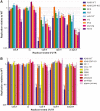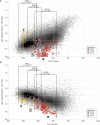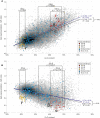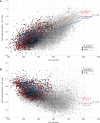Comparison of CpG- and UpA-mediated restriction of RNA virus replication in mammalian and avian cells and investigation of potential ZAP-mediated shaping of host transcriptome compositions
- PMID: 35675984
- PMCID: PMC9297844
- DOI: 10.1261/rna.079102.122
Comparison of CpG- and UpA-mediated restriction of RNA virus replication in mammalian and avian cells and investigation of potential ZAP-mediated shaping of host transcriptome compositions
Abstract
The ability of zinc finger antiviral protein (ZAP) to recognize and respond to RNA virus sequences with elevated frequencies of CpG dinucleotides has been proposed as a functional part of the vertebrate innate immune antiviral response. It has been further proposed that ZAP activity shapes compositions of cytoplasmic mRNA sequences to avoid self-recognition, particularly mRNAs for interferons (IFNs) and IFN-stimulated genes (ISGs) expressed during the antiviral state. We investigated whether restriction of the replication of mutants of influenza A virus (IAV) and the echovirus 7 (E7) replicon with high CpG and UpA frequencies varied in different species of mammals and birds. Cell lines from different bird orders showed substantial variability in restriction of CpG-high mutants of IAV and E7 replicons, whereas none restricted UpA-high mutants, in marked contrast to universal restriction of both mutants in mammalian cells. Dinucleotide representation in ISGs and IFN genes was compared with those of cellular transcriptomes to determine whether potential differences in inferred ZAP activity between species shaped dinucleotide compositions of highly expressed genes during the antiviral state. While mammalian type 1 IFN genes typically showed often profound suppression of CpG and UpA frequencies, there was no oversuppression of either in ISGs in any species, irrespective of their ability to restrict CpG- or UpA-high mutants. Similarly, genome sequences of mammalian and avian RNA viruses were compositionally equivalent, as were IAV strains recovered from ducks, chickens and humans. Overall, we found no evidence for host variability in inferred ZAP function shaping host or viral transcriptome compositions.
Keywords: RNA virus; dinucleotide; interferon; interferon-stimulated gene; trancriptome; zinc finger antiviral protein.
© 2022 Odon et al.; Published by Cold Spring Harbor Laboratory Press for the RNA Society.
Figures












Similar articles
-
Versatility of the Zinc-Finger Antiviral Protein (ZAP) As a Modulator of Viral Infections.Int J Biol Sci. 2024 Aug 26;20(12):4585-4600. doi: 10.7150/ijbs.98029. eCollection 2024. Int J Biol Sci. 2024. PMID: 39309436 Free PMC article. Review.
-
Association of Zinc Finger Antiviral Protein Binding to Viral Genomic RNA with Attenuation of Replication of Echovirus 7.mSphere. 2021 Jan 6;6(1):e01138-20. doi: 10.1128/mSphere.01138-20. mSphere. 2021. PMID: 33408233 Free PMC article.
-
The role of ZAP and OAS3/RNAseL pathways in the attenuation of an RNA virus with elevated frequencies of CpG and UpA dinucleotides.Nucleic Acids Res. 2019 Sep 5;47(15):8061-8083. doi: 10.1093/nar/gkz581. Nucleic Acids Res. 2019. PMID: 31276592 Free PMC article.
-
The dinucleotide composition of the Zika virus genome is shaped by conflicting evolutionary pressures in mammalian hosts and mosquito vectors.PLoS Biol. 2021 Apr 19;19(4):e3001201. doi: 10.1371/journal.pbio.3001201. eCollection 2021 Apr. PLoS Biol. 2021. PMID: 33872300 Free PMC article.
-
Does the Zinc Finger Antiviral Protein (ZAP) Shape the Evolution of Herpesvirus Genomes?Viruses. 2021 Sep 17;13(9):1857. doi: 10.3390/v13091857. Viruses. 2021. PMID: 34578438 Free PMC article. Review.
Cited by
-
Mapping evolutionary paradigm of bovine viral diarrhea virus Npro associated with different organizations of nucleotide.Virulence. 2025 Dec;16(1):2550620. doi: 10.1080/21505594.2025.2550620. Epub 2025 Aug 29. Virulence. 2025. PMID: 40879629 Free PMC article.
-
Differential RNA editing landscapes in host cell versus the SARS-CoV-2 genome.iScience. 2023 Sep 30;26(11):108031. doi: 10.1016/j.isci.2023.108031. eCollection 2023 Nov 17. iScience. 2023. PMID: 37876814 Free PMC article.
-
Depletion of CpG dinucleotides in bacterial genomes may represent an adaptation to high temperatures.NAR Genom Bioinform. 2024 Jul 27;6(3):lqae088. doi: 10.1093/nargab/lqae088. eCollection 2024 Sep. NAR Genom Bioinform. 2024. PMID: 39071851 Free PMC article.
-
An APOBEC3 Mutational Signature in the Genomes of Human-Infecting Orthopoxviruses.mSphere. 2023 Apr 20;8(2):e0006223. doi: 10.1128/msphere.00062-23. Epub 2023 Mar 15. mSphere. 2023. PMID: 36920219 Free PMC article.
-
Versatility of the Zinc-Finger Antiviral Protein (ZAP) As a Modulator of Viral Infections.Int J Biol Sci. 2024 Aug 26;20(12):4585-4600. doi: 10.7150/ijbs.98029. eCollection 2024. Int J Biol Sci. 2024. PMID: 39309436 Free PMC article. Review.
References
Publication types
MeSH terms
Substances
Grants and funding
- BB/N023803/1/BB_/Biotechnology and Biological Sciences Research Council/United Kingdom
- BB/K004468/1/BB_/Biotechnology and Biological Sciences Research Council/United Kingdom
- BB/M011224/1/BB_/Biotechnology and Biological Sciences Research Council/United Kingdom
- WT_/Wellcome Trust/United Kingdom
- WT103767MA/WT_/Wellcome Trust/United Kingdom
LinkOut - more resources
Full Text Sources
Miscellaneous
